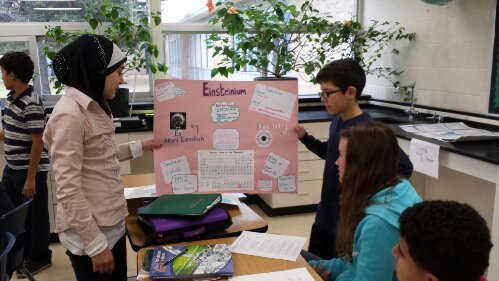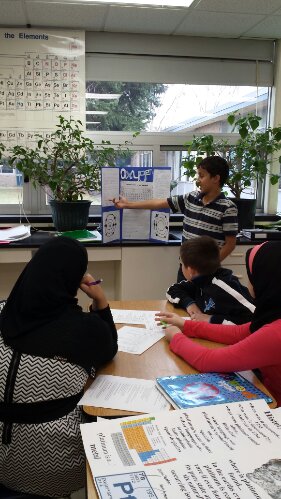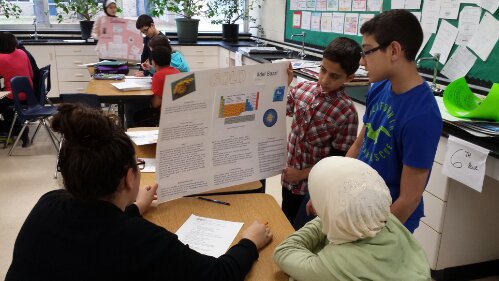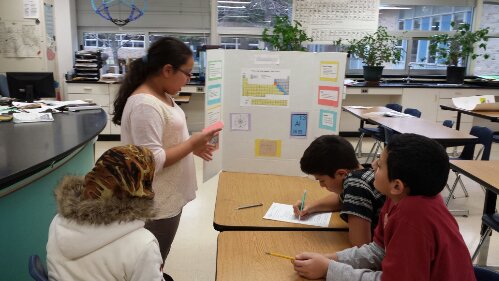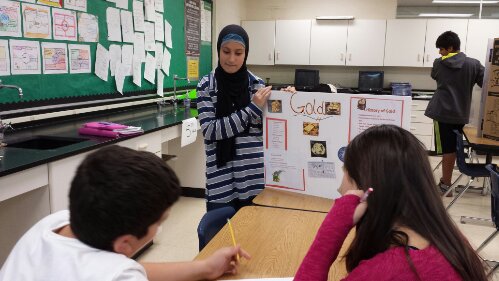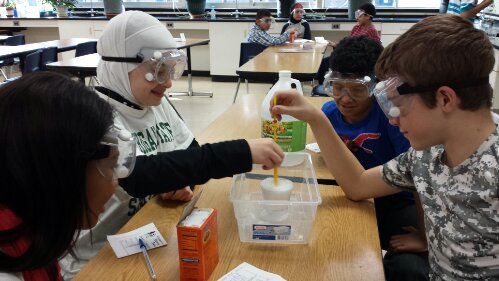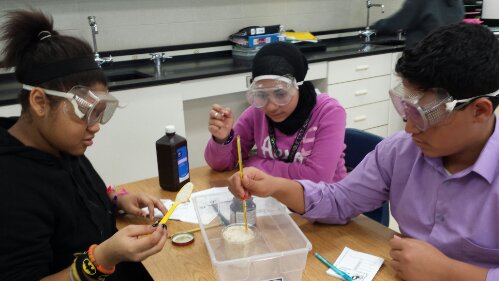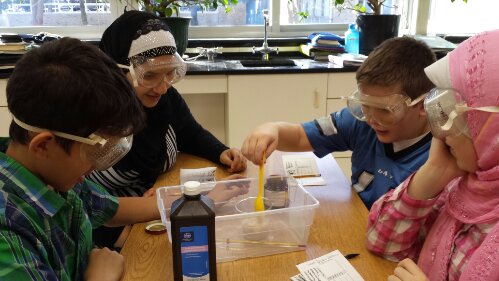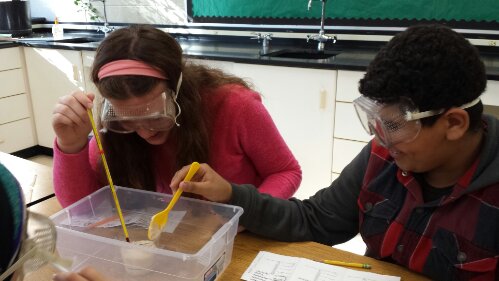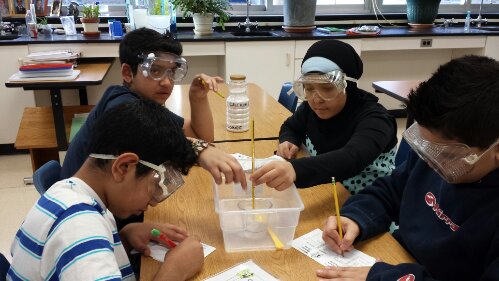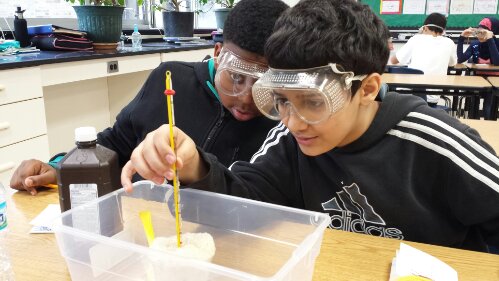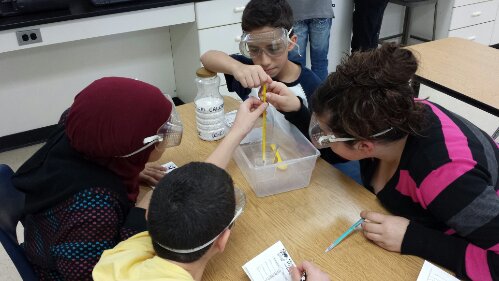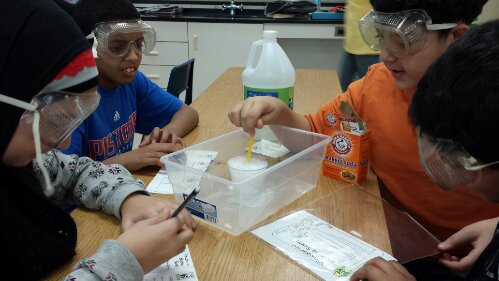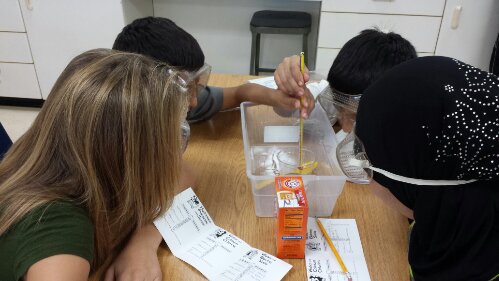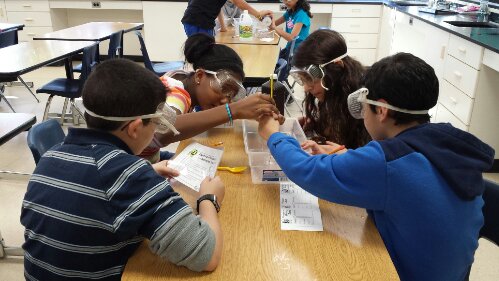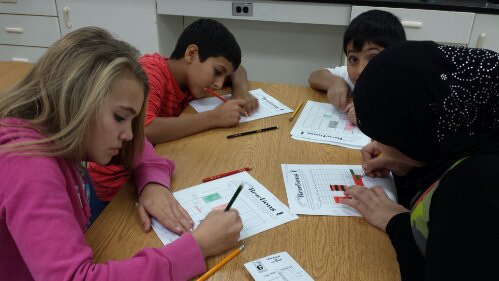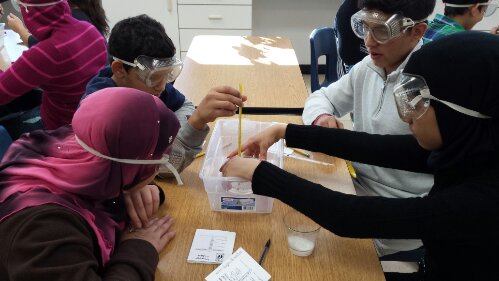Tie A Tie B
Blended Learning
Test Next Wednesday (11/11/13)
There will be a test next Wednesday. I will attach a study guide to this post.
Chapter 3
Study Guide
- Characteristic Properties – properties elements that do not depend on the amount of the element
- Physical Properties – properties of matter that can be observed or measured without changing the substance’s identity or composition
- Examples:
- Density – relationship between mass and volume
- State – solid, liquid or gas
- Color
- Solubility – ability to dissolve
- Ductility – ability to be pulled into a wire
- Malleability – ability to be pounded into thin sheets
- Thermal Conductivity – ability to conduct heat
- Odor
- Volume—amount of space taken up
- Physical Change – change in matter that does not change the substance’s composition
- Examples: cutting wood, melting a popsicle
- Physical changes do NOT change the composition of the substance.
- Chemical Properties – properties of matter that describe the substance’s ability to participate in a chemical reaction
- Examples:
- Flammability – ability to burn
- Reactivity – ability of 2 or more substances to combine to form other substances (ex. reactivity with acid, reactivity with water)
- pH Scale – measures how acidic or basic a substance is
- Chemical Change (reaction) – the process of changing a substance into an entirely new substance
- In a chemical change, the substance’s composition changes.
- Examples: fireworks exploding, iron rusting, milk souring
- Chemical changes may cause bubbling or foaming or color change or produce heat, light or sound.
- Elements – a pure substance that cannot be separated into simpler substances by physical or chemical means
- The smallest particle of an element that can still be classified as that element is an atom.
- All particles of an element are identical.
- Metals are shiny elements that conduct heat and electric current well. Iron is an example of a metal.
- Nonmetals conduct heat and electricity poorly and can be a solid, liquid or gas. Sulfur is an example of a nonmetal.
- Metalloids are elements that have properties of both metals and nonmetals. Silicon is an example of a metalloid.
- Compounds – pure substances composed of two or more elements that are chemically combined
- The smallest particle of a compound that can still be classified as that compound is a molecule.
- All particles of a compound are identical.
- Compounds have different properties than the elements that form them, for example Sodium (Na) and Chlorine (Cl) are both poisonous elements but they chemically combine to form Sodium Chloride (NaCl) which is table salt that we eat.
- Compounds can only be broken down by chemical changes
- Compounds form in specific ratios and all particles are the same.
- Carbon dioxide (CO2) is an example of a compound. Animals breathe out carbon dioxide and plants take it in to use in photosynthesis.
- Mixtures – combinations of two or more substances that are not chemically combined
- When elements form mixtures, the elements keep their original properties.
- Mixtures are not pure substances.
- All particles of mixtures are not identical.
- Mixtures can be separated physically.
- Mixtures do not form in specific ratios and particles are not all the same.
- Pure Substances – Elements and Compounds are considered “pure substances” because all of their particles are identical. Mixtures are not considered pure substances because they are made up of different types of particles.
- Periodic Table – Elements are organized according to similar properties of reactivity.
- Chemical Reactions – Reactants and Products
- Reactants are the substances before they chemically react.
- Products are the new substances formed by the chemical reaction.
- Example:
- Vinegar and baking soda are combined to give off carbon dioxide gas.
- The reactants are vinegar and baking soda.
- The product is the carbon dioxide gas.
Photos of student Element Posters presented in groups.
Photos from the Chemical reactions lab
Today’s Assignment
Element Poster -or- Power Point Project is due Monday
About a week and a half ago the Element Poster -or- Power Point Project was assigned with the due date of November 25th. The 25th is this coming Monday. The student’s have had one day in the computer lab (last Wednesday) and another day in the computer lab tomorrow (this Wednesday). The students will also be presenting their element project to the class.
See below for the assignment rubric.
ELEMENT Student Name________________________
POSTER or POWER POINT
RUBRIC
Pre and Post-Research Requirements (15 points possible)
_____ (15 pts) Using class and computer lab time wisely for research efforts
Poster (100 points possible)
1. History:
_____ (5 pts) When was it discovered? (actual date or time period)
Who was it discovered by? (if possible)
Who, what or where was it named after?
What language is its element symbol is based on?
_____ (5 pts) List its name in at least three other languages.
2. Properties of the Element
_____ (5 pts) Chemical Properties (flammable, reactivity, etc.)
_____ (5 pts) Physical Properties (color, melting point, state of matter at room
temperature, etc.)
_____ (5 pts) Include a graphic (photograph of element or other visual representation)
_____ (5 pts) Include a drawing of the atomic structure of one atom of the element
3. List of Uses and where it is found
_____ (5 pts) What are the common uses of this element?
– Industrial uses, everyday uses (if none, explain why)
_____ (5 pts) Where is this element found in nature?
– Common forms of the element
– Common compounds in which it is found
4. Information from Periodic Table of Elements:
_____ (5 pts) – The location of the element marked on a periodic table on the poster.
_____ (5 pts) – Include an enlargement of the Atomic Symbol and Atomic Number.
_____ (5 pts) – States whether it is classified as a Metal, Nonmetal or Metalloid.
5. Organization and Neatness
_____ (5 pts) Creative and eye-appealing arrangement
_____ (5 pts) Neatness and use of color without pencil markings (unless “shaded”)
_____ (5 pts) Facts are presented in bullet/statement form (NOT paragraphs)
Class Presentation (15 points possible)
_____ (5 pts) Clearly organized and/or prepared (3 x 5 cards fine as a guide)
_____ (5 pts) Spoken clearly with voice and presence
_____ (5 pts) Provided facts with meaning and interest for audience
Test Wednesday, No School on Tuesday (election day)
The Chapter One Matter Test will be Wednesday. Students should study a bit each day. There are Power Points and an online article to help with studying on my iLearn site. With no school for students on Tuesday there is plenty of time to study. Use your time wisely.
The MEAPs are complete! & Make sure that you get your sleep!
We are finished with the MEAP schedule for the year and are back to our regular schedule. This will allow us to focus on the curriculum and move a bit faster. Students should spend a bit of time at home making sure that they are organized and ready to go each day. They should also make sure that their bodies are well fed and well rested. I have copied and pasted an article about the value of sleep below.
Sleep ‘cleans’ the brain of toxins
By James GallagherHealth and science reporter, BBC News
The brain uses sleep to wash away the waste toxins built up during a hard day’s thinking, researchers have shown.
The US team believes the “waste removal system” is one of the fundamental reasons for sleep.
Their study, in the journal Science, showed brain cells shrink during sleep to open up the gaps between neurons and allow fluid to wash the brain clean.
They also suggest that failing to clear away some toxic proteins may play a role in brain disorders.
One big question for sleep researchers is why do animals sleep at all when it leaves them vulnerable to predators?
It has been shown to have a big role in the fixing of memories in the brain and learning, but a team at the University of Rochester Medical Centre believes that “housework” may be one of the primary reasons for sleep.
“The brain only has limited energy at its disposal and it appears that it must choose between two different functional states – awake and aware or asleep and cleaning up,” said researcher Dr. Maiken Nedergaard.
“You can think of it like having a house party. You can either entertain the guests or clean up the house, but you can’t really do both at the same time.”
Plumbing
Their findings build on last year’s discovery of the brain’s own network of plumbing pipes – known as the glymphatic system – which carry waste material out of the brain.
Scientists, who imaged the brains of mice, showed that the glymphatic system became 10-times more active when the mice were asleep.
Cells in the brain, probably the glial cells which keep nerve cells alive, shrink during sleep. This increases the size of the interstitial space, the gaps between brain tissue, allowing more fluid to be pumped in and wash the toxins away.
Dr Nedergaard said this was a “vital” function for staying alive, but did not appear to be possible while the mind was awake. She told the BBC: “This is purely speculation, but it looks like the brain is losing a lot of energy when pumping water across the brain and that is probably incompatible with processing information.”
She added that the true significance of the findings would be known only after human studies, but doing similar experiments in an MRI machine would be relatively easy.
Commenting on the research Dr Neil Stanley, an independent sleep expert, said: “This is a very interesting study that shows sleep is essential downtime to do some housekeeping to flush out neurotoxins.
“There is good data on memory and learning, the psychological reason for sleep. But this is the actual physical and chemical reason for sleep, something is happening which is important.”
Dr Raphaelle Winsky-Sommerer, a lecturer in sleep at Surrey University, said: “It’s not surprising, our whole physiology is changing during sleep.”
“The novelty is the role of the interstitial space, but I think it’s an added piece of the puzzle not the whole mechanism.
“The significance is that, yet again, it shows sleep may contribute to the restoration of brain cell function and may have protective effects.”
Many conditions which lead to the loss of brain cells such as Alzheimer’s or Parkinson’s disease are characterized by the build-up of damaged proteins in the brain.
The researchers suggest that problems with the brain’s cleaning mechanism may contribute to such diseases, but caution more research is needed.
The charity Alzheimer’s Research UK said more research would be needed to see whether damage to the brain’s waste clearance system could lead to diseases like dementia, but the findings offered a “potential new avenue for investigation”.
MEAP time
Today marks the first day of MEAP testing. We will be testing in the mornings on MEAP days and have shortened classes in the afternoon.
We had our first test on Monday (yesterday) and each student will be notified about their grade in class today. If a student plans to make a second attempt on this test they need to do so immediately as the card marking ends this Friday. They need to see me to pick up the form and to schedule their meeting and retake date. Reminder: All retakes are scheduled for after school.



